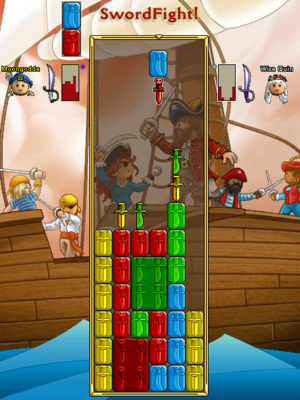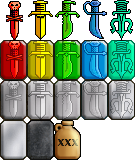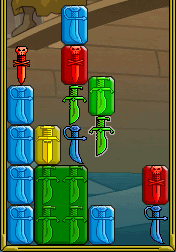Difference between revisions of "Swordfight"
m (+add File:Official-Swordstrike.png) |
Therobotdude (talk | contribs) m (3p; minor reword) |
||
| Line 12: | Line 12: | ||
== Gameplay == | == Gameplay == | ||
| − | Swordfighting is about clearing pieces from | + | Swordfighting is about clearing pieces from the board in order to fill up the opponent's board. As the fight progresses, boards become more difficult to keep clear as there are more pieces in play and incoming attacks get larger. Pieces enter the board two at a time, from the fourth column of the board. When the fourth column becomes completely full (meaning no more pieces can enter the board) the player is defeated. |
=== Pieces === | === Pieces === | ||
[[Image:Sword_pieces.png|right]] | [[Image:Sword_pieces.png|right]] | ||
| − | There are two different types of pieces: solid blocks and cutout "breakers". These pieces come in one of four colors: red, yellow, green, and blue. Additionally, there | + | There are two different types of pieces: solid blocks and cutout "breakers". These pieces come in one of four colors: red, yellow, green, and blue. Additionally, there is also an aqua block in the shape of a [[trident]] for when a pirate is facing [[dragoon]]s, and purple blocks in [[Haunted seas]] frays. Each of the colors have a distinct shape and a recognizable outline. Opaque gray blocks will also appear throughout the course of a swordfight as the opponent sends sprinkles or strikes. These gray blocks decay to translucent blocks the following turn, and become normal blocks after that. On ships, solid black blocks represent [[Sea battle#damage chart|damage]] pirates have taken, and jug-shaped blocks indicate that the ship is out of [[rum]]). |
{{clear}} | {{clear}} | ||
=== Clearing pieces === | === Clearing pieces === | ||
[[Image:sword_drop.png|right]] | [[Image:sword_drop.png|right]] | ||
| − | Sword pieces fall from the top of the screen. Breakers will shatter all connecting pieces of the same color and send an attack proportional to the size of the shatter to | + | Sword pieces fall from the top of the screen. Breakers will shatter all connecting pieces of the same color and send an attack proportional to the size of the shatter to the opponent. These attacks are described in detail [[swordfight#how breaks strike opponents|below]]. When solid blocks of the same color which are placed together in a rectangle, where both dimensions are at least two blocks, they will fuse into a large rectangular formation. Fused blocks will send sword strikes to the opponent when cleared, depending on their size. |
{{clear}} | {{clear}} | ||
=== Purple blocks === | === Purple blocks === | ||
| Line 28: | Line 28: | ||
Purple blocks are seen in [[Haunted Seas]], and form part of the drop pattern from ghostly enemies. The developers have stated they have no intention of adding purple blocks to other environments such as [[pillaging]], [[tournament]]s, or player duels. {{fn|1=http://forums.puzzlepirates.com/community/mvnforum/viewthread?p=2214487#2214487}} | Purple blocks are seen in [[Haunted Seas]], and form part of the drop pattern from ghostly enemies. The developers have stated they have no intention of adding purple blocks to other environments such as [[pillaging]], [[tournament]]s, or player duels. {{fn|1=http://forums.puzzlepirates.com/community/mvnforum/viewthread?p=2214487#2214487}} | ||
| − | == Achieving the | + | == Achieving the greatest breaks == |
[[Image:Sword_2x2.png|right|frame|A uncomboed 2x2 block becomes a 1x4 vertical sword. This is one exception to the rule that the swords are the same size and shape as the blocks that caused them. Other exceptions include 3x3 and any piece where both the width and the height are 4 or greater.]] | [[Image:Sword_2x2.png|right|frame|A uncomboed 2x2 block becomes a 1x4 vertical sword. This is one exception to the rule that the swords are the same size and shape as the blocks that caused them. Other exceptions include 3x3 and any piece where both the width and the height are 4 or greater.]] | ||
| − | Pieces of the same color in blocks solidify into a large block if they are arranged in a 2 x 2 or greater rectangular formation. When broken, vertical blocks send vertical swords to | + | Pieces of the same color in blocks solidify into a large block if they are arranged in a 2 x 2 or greater rectangular formation. When broken, vertical blocks send vertical swords to the opponent; horizontal blocks send horizontal swords (which can be difficult to overcome if well-placed). |
These swords appear as an immovable image of a sword for one turn. They become a mass of grey blocks the next turn, and fall down where possible. On the third turn, those grey blocks will show a sword image (like regular pieces but without the color). Finally the grey blocks turn into regular pieces on the fourth turn. | These swords appear as an immovable image of a sword for one turn. They become a mass of grey blocks the next turn, and fall down where possible. On the third turn, those grey blocks will show a sword image (like regular pieces but without the color). Finally the grey blocks turn into regular pieces on the fourth turn. | ||
===Minor Breaks (Sprinkles)=== | ===Minor Breaks (Sprinkles)=== | ||
| − | When | + | When breaking pieces that were not part of a larger block, they become single grey blocks that fall into the opponent's board. These, too, can be devastating if placed correctly. Without using a chain, one sprinkle block is created for every two loose blocks shattered. If an uneven number are broken, the value is rounded down. Breakers count as loose blocks. |
===Chaining=== | ===Chaining=== | ||
| − | The most devastating breaks come from ''[[chain]]s''. When a block is broken, the pieces above it fall onto the pieces below. Being able to make double, triple, bingo, donkey, vegas, or greater chains, will multiply | + | The most devastating breaks come from ''[[chain]]s''. When a block is broken, the pieces above it fall onto the pieces below. Being able to make double, triple, bingo, donkey, vegas, or greater chains, will multiply the attacks sent. |
{| | {| | ||
|-valign=top | |-valign=top | ||
| Line 91: | Line 91: | ||
*[http://forums.puzzlepirates.com/community/mvnforum/viewthread?thread=5091 Tedv's Everything about Everything about Swords post] (somewhat outdated) | *[http://forums.puzzlepirates.com/community/mvnforum/viewthread?thread=5091 Tedv's Everything about Everything about Swords post] (somewhat outdated) | ||
*[http://forums.puzzlepirates.com/community/mvnforum/viewthread?thread=7069 RobertDonald's Swordfighting Guide] Relevant | *[http://forums.puzzlepirates.com/community/mvnforum/viewthread?thread=7069 RobertDonald's Swordfighting Guide] Relevant | ||
| − | *[http://forums.puzzlepirates.com/community/mvnforum/viewthread?p=55954 Jack's Strike Pattern Inner Workings] explains what | + | *[http://forums.puzzlepirates.com/community/mvnforum/viewthread?p=55954 Jack's Strike Pattern Inner Workings] explains what the opponent gets |
*[http://www.rustycutlass.org/portal.php?module=sword&mpage=swordcolours Rusty Cutlass Sword pattern tool] calculates what Jack said for a particular sword. | *[http://www.rustycutlass.org/portal.php?module=sword&mpage=swordcolours Rusty Cutlass Sword pattern tool] calculates what Jack said for a particular sword. | ||
*[http://www.youtube.com/watch?v=bFFGz1o-shs Alexaleo's Breaker Stacking Swordfighting Video] | *[http://www.youtube.com/watch?v=bFFGz1o-shs Alexaleo's Breaker Stacking Swordfighting Video] | ||
Revision as of 15:19, 31 August 2013
Swordfighting (often abbreviated as sf) is a multiplayer puzzle. The puzzle can be played in many different settings. It is available from the tournament board or as a parlor game. (When played with more than two people, the swordfight is known as a brawl.) Players can challenge NPPs or other players to a swordfight and utilize swords to defeat them. In addition, the final phase of a sea battle against brigands is a swordfight. While in Atlantis, players may be challenged to brawls by an NPP and the entire ship may enter a swordfight while inside a citadel.
Swordfighting is free to play three days a week. Swordfighting at sea and via a player challenge is always free.
Contents
[hide]Controls
Though controls can be customized under the options screen, the default controls are as follows:
- Left and Right arrows - move left and right
- Up and Down arrows - rotate counter-clockwise and clockwise
- Space - drops quickly
- A and S - switches opponent up/down
- [ and ] - same as A and S
Gameplay
Swordfighting is about clearing pieces from the board in order to fill up the opponent's board. As the fight progresses, boards become more difficult to keep clear as there are more pieces in play and incoming attacks get larger. Pieces enter the board two at a time, from the fourth column of the board. When the fourth column becomes completely full (meaning no more pieces can enter the board) the player is defeated.
Pieces
There are two different types of pieces: solid blocks and cutout "breakers". These pieces come in one of four colors: red, yellow, green, and blue. Additionally, there is also an aqua block in the shape of a trident for when a pirate is facing dragoons, and purple blocks in Haunted seas frays. Each of the colors have a distinct shape and a recognizable outline. Opaque gray blocks will also appear throughout the course of a swordfight as the opponent sends sprinkles or strikes. These gray blocks decay to translucent blocks the following turn, and become normal blocks after that. On ships, solid black blocks represent damage pirates have taken, and jug-shaped blocks indicate that the ship is out of rum).
Clearing pieces
Sword pieces fall from the top of the screen. Breakers will shatter all connecting pieces of the same color and send an attack proportional to the size of the shatter to the opponent. These attacks are described in detail below. When solid blocks of the same color which are placed together in a rectangle, where both dimensions are at least two blocks, they will fuse into a large rectangular formation. Fused blocks will send sword strikes to the opponent when cleared, depending on their size.
Purple blocks
Purple blocks are special pieces that can appear as part of a drop pattern. Unlike normal blocks, they will not fuse together. They can be cleared with breakers of any color, as long as they are touching the pieces which break. Any adjacent breaker can clear purple blocks, however if breaker is adjacent to only purple blocks, it doesn't act as an universal block and only the purple is cleared. Markings on each block show how many pieces can enter the board before it turns in to an unclearable black block.
Purple blocks are seen in Haunted Seas, and form part of the drop pattern from ghostly enemies. The developers have stated they have no intention of adding purple blocks to other environments such as pillaging, tournaments, or player duels. [1]
Achieving the greatest breaks
Pieces of the same color in blocks solidify into a large block if they are arranged in a 2 x 2 or greater rectangular formation. When broken, vertical blocks send vertical swords to the opponent; horizontal blocks send horizontal swords (which can be difficult to overcome if well-placed).
These swords appear as an immovable image of a sword for one turn. They become a mass of grey blocks the next turn, and fall down where possible. On the third turn, those grey blocks will show a sword image (like regular pieces but without the color). Finally the grey blocks turn into regular pieces on the fourth turn.
Minor Breaks (Sprinkles)
When breaking pieces that were not part of a larger block, they become single grey blocks that fall into the opponent's board. These, too, can be devastating if placed correctly. Without using a chain, one sprinkle block is created for every two loose blocks shattered. If an uneven number are broken, the value is rounded down. Breakers count as loose blocks.
Chaining
The most devastating breaks come from chains. When a block is broken, the pieces above it fall onto the pieces below. Being able to make double, triple, bingo, donkey, vegas, or greater chains, will multiply the attacks sent.
How Breaks Strike Opponents
Note: Strikes against NPPs do not follow these rules.
To learn more about how strikes affect opponents, read the excellent forum posts by Tedv, Robertdonald, and Jack in the External Links section below.
Influences
This puzzle's mechanics were heavily influenced by Super Puzzle Fighter 2 Turbo for arcades and later various consoles, which later influenced Puzzle Kombat (part of Mortal Kombat Deception for the PlayStation 2).
Historical Notes
- In the original version of the sea battle swordfight, a maximum of 10 rows of black blocks could be achieved (if a ship had become fully damaged). This was lowered to 6 rows in Beta release 2003-11-22. The amount of black blocks a cannonball added was not changed, just that the maximum damage level for swordfighting was lowered.
- Rum bottles in the sea battle swordfight in release 2005-04-26. Previously if a ship was out of rum, there was no penalty in swordfights.
Ultimate list
| Cerulean | Emerald | Ice |
|---|---|---|
| Jade | Meridian | Obsidian |
| Opal | ||
Trophies
External/Other Links
- Black Death Sword and Sprinkle Placement Guide
- Commonly discussed ideas from Game Design
- Official game documents
- Tedv's Everything about Everything about Swords post (somewhat outdated)
- RobertDonald's Swordfighting Guide Relevant
- Jack's Strike Pattern Inner Workings explains what the opponent gets
- Rusty Cutlass Sword pattern tool calculates what Jack said for a particular sword.
- Alexaleo's Breaker Stacking Swordfighting Video
- Swordfighting Video
- Everything about Everything about Swords
- Scervy's Youtube Defeating Advanced Players Swordfight Guide
- Bailet's Swordfighting video - Saber and Falchion
- Guantanamo's swordfighting montage
| |||
| See also: Swordfighting | Drop pattern | Brawl | |||
| |
| See also: Tournament |























